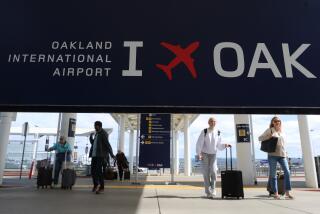American Airlines to Halt O.C. Flights to San Francisco : Air service: The airline plans to drop its five daily round trips Nov. 1 because they have not been profitable.
- Share via
American Airlines said Tuesday that it will drop all five of its daily round trips from Orange County to San Francisco Nov. 1, reducing the choice of flights for travelers and puncturing a widely held belief that every route of John Wayne Airport is a profitable one.
“This route has not been profitable for us,” said Mel Olsen, American’s vice president for marketing and planning. “The load factors have been quite light. . . . We don’t have any plans to reenter this market.”
The big winner, airport officials said, appears to be United Airlines and United Express, a Fresno-based commuter line that has a marketing agreement with United. The carriers began flying to San Francisco in March and offer a total of eight flights, increasing total seat capacity on the route by 45%, said Alan Murphy, project manager at John Wayne.
John Wayne has long been considered one of the country’s most lucrative ports for airlines because most of its users are business travelers who pay top dollars for their tickets. Also surveys show that the Orange County market is significantly underserved.
As a result airlines, including American, have gone to court to push their way into John Wayne and lobbied hard to win new flights that became available with the recent expansion of the terminal.
The loss of the American flights means there will be 15 daily flights to San Francisco and a 19% decrease in the number of seats available on the route. But Murphy said there is sufficient unsold seat capacity on other carriers to handle that much and more.
“We don’t think this will have any impact on the traveling public,” Murphy said.
Olsen said American is giving up its Orange County-San Francisco routes because it decided recently to retire its fleet of six BAe 146s, all of which are committed to the route. American announced its intention to retire the planes on Sept. 29 but did not disclose at the time what effect it would have on service.
Olsen said the BAe 146 aircraft have higher operating expenses than newer, bigger planes in American’s fleet. While Olsen had no figures, airport officials said it costs nearly twice as much per hour to operate the BAe 146 as some newer, larger aircraft that can seat many more people, travel much farther, and which are only slightly noisier.
The BAe 146 was heralded as a great technological success story at John Wayne when it was introduced five years ago because its quieter engines meant its use was not restricted by Orange County’s tough noise standards.
Spokesmen for the three remaining airlines serving San Francisco from John Wayne Airport said they don’t expect ticket prices to increase because competition will remain stiff on the route. Currently, the airlines are charging $60 for a discounted, 21-day advance purchase round-trip ticket, but the unrestricted, one-way fare is a whopping $204.
USAir has seven daily flights to San Francisco while United Express and United each have four. Both USAir and United Express use BAe 146s on the route, and officials for both airlines said they have no plans to remove the aircraft from service.
United Airlines spokesman Joe Hopkins said the Chicago-based air carrier currently uses Boeing 737-300s on the route but plans to substitute bigger Boeing 757 aircraft after Oct. 31. The 757 can seat between 174 and 224 passengers compared to the 737’s 128 and the BAe 146s 71 to 81.
“We have seats open,” said USAir Assistant Vice President Larry Pickett. “I expect we and the other carriers will pick up the slack.”
Spokesmen for the two airlines said their flights to San Francisco are still profitable even with 40% to 50% of their seats unsold.
“This is a (profit) contributing route,” said United Express spokesman Mark Peterson. “We are very pleased with the route despite the recent hike in fuel costs.”
Peterson said jet fuel has increased from 74 cents per gallon in July to $1.25 a gallon. Every penny increase means extra costs of $415,000 on an annualized basis, he said.
“It’s a very significant hit,” Peterson added.
More to Read
Inside the business of entertainment
The Wide Shot brings you news, analysis and insights on everything from streaming wars to production — and what it all means for the future.
You may occasionally receive promotional content from the Los Angeles Times.










